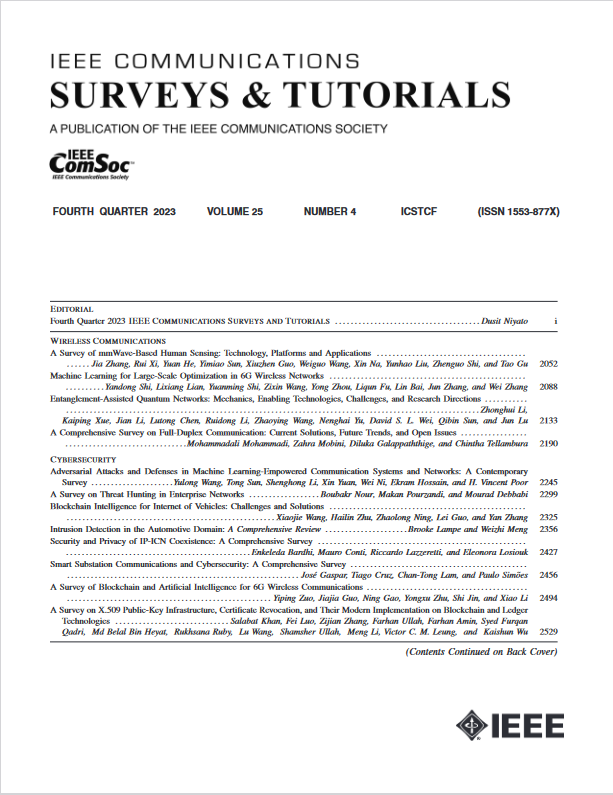Active Reconfigurable Intelligent Surfaces: Expanding the Frontiers of Wireless Communication-A Survey
IF 34.4
1区 计算机科学
Q1 COMPUTER SCIENCE, INFORMATION SYSTEMS
引用次数: 0
Abstract
The swift progress of metasurface technology, enabling meticulous manipulation of the propagation environment, is anticipated to bring a transformative impact on sixth-generation (6G) wireless communications efficiency. Utilizing metasurface elements presents a promising opportunity for achieving passive scattering at sub-wavelength scales, facilitating intelligent radio settings’ advancement. Active Reconfigurable Intelligent Surfaces (ARIS) have gained significant interest in emergent metasurface technology. In contrast to passive RIS, which exhibits a certain degree of performance enhancement but encounters restrictions arising from the “double fading” phenomenon in the phase response, ARIS emerges as a highly promising alternative to counter such restrictions. This study provides a complete examination of ARIS, particularly emphasizing current improvements and its various uses within the context of 6G wireless networks. The review commences by laying a robust foundation in RIS technology, covering the various types and modes of RIS. Following this, we will explore the benefits and practical implementations of ARIS. Through a systematic examination, we categorize different approaches within ARIS-enabled use cases. These scenarios include optimizing the sum rate and signal-to-noise ratio, attaining maximum secrecy rate, energy minimization, and ensuring channel estimation. Additionally, we provide a summary and lessons learned along with a summary table for each category to describe, contrast, and evaluate the existing literature regarding setup, channel characteristics, methodologies, and objectives. We highlight the crucial role of ARIS in defining the landscape of wireless communications in the 6G era by outlining the open research problems in this emerging area and exploring the attractive future prospects.主动式可重构智能表面:拓展无线通信前沿--概览
超表面技术的迅速发展,使得对传播环境的细致控制成为可能,预计将对第六代(6G)无线通信效率带来变革性影响。利用超表面元件为实现亚波长尺度的被动散射提供了一个有希望的机会,促进了智能无线电设置的进步。主动可重构智能表面(ARIS)在新兴的超表面技术中引起了极大的兴趣。被动RIS表现出一定程度的性能增强,但在相位响应中遇到“双重衰落”现象所带来的限制,与之相反,ARIS成为一种非常有前途的替代方案,可以克服这些限制。本研究对ARIS进行了全面的研究,特别强调了当前的改进及其在6G无线网络背景下的各种用途。本文首先为RIS技术打下坚实的基础,涵盖了RIS的各种类型和模式。接下来,我们将探讨ARIS的优点和实际实现。通过系统的检查,我们在支持aris的用例中对不同的方法进行了分类。这些场景包括优化求和速率和信噪比、实现最大保密速率、能量最小化和确保信道估计。此外,我们还提供了总结和经验教训,以及每个类别的汇总表,以描述、对比和评估有关设置、渠道特征、方法和目标的现有文献。我们通过概述这一新兴领域的开放研究问题并探索具有吸引力的未来前景,强调ARIS在定义6G时代无线通信前景方面的关键作用。
本文章由计算机程序翻译,如有差异,请以英文原文为准。
求助全文
约1分钟内获得全文
求助全文
来源期刊

IEEE Communications Surveys and Tutorials
COMPUTER SCIENCE, INFORMATION SYSTEMS-TELECOMMUNICATIONS
CiteScore
80.20
自引率
2.50%
发文量
84
审稿时长
6 months
期刊介绍:
IEEE Communications Surveys & Tutorials is an online journal published by the IEEE Communications Society for tutorials and surveys covering all aspects of the communications field. Telecommunications technology is progressing at a rapid pace, and the IEEE Communications Society is committed to providing researchers and other professionals the information and tools to stay abreast. IEEE Communications Surveys and Tutorials focuses on integrating and adding understanding to the existing literature on communications, putting results in context. Whether searching for in-depth information about a familiar area or an introduction into a new area, IEEE Communications Surveys & Tutorials aims to be the premier source of peer-reviewed, comprehensive tutorials and surveys, and pointers to further sources. IEEE Communications Surveys & Tutorials publishes only articles exclusively written for IEEE Communications Surveys & Tutorials and go through a rigorous review process before their publication in the quarterly issues.
A tutorial article in the IEEE Communications Surveys & Tutorials should be designed to help the reader to become familiar with and learn something specific about a chosen topic. In contrast, the term survey, as applied here, is defined to mean a survey of the literature. A survey article in IEEE Communications Surveys & Tutorials should provide a comprehensive review of developments in a selected area, covering its development from its inception to its current state and beyond, and illustrating its development through liberal citations from the literature. Both tutorials and surveys should be tutorial in nature and should be written in a style comprehensible to readers outside the specialty of the article.
 求助内容:
求助内容: 应助结果提醒方式:
应助结果提醒方式:


